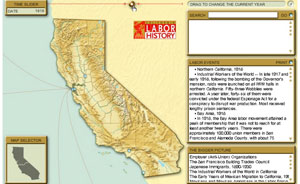talking history | syllabi | students | teachers | puzzle | about us
California Labor History
http://calpedia.sfsu.edu/calabor/
Daniel A. Cornford, David Fuller, Rory Litwin, Charlene Wear Simmons, and Fred Glass, in association with the California Labor History Map Advisory Committee
Reviewed June 16—20, 2008.
The California Labor History Web site offers students and researchers an overview of the state’s working-class history, using a map of California to situate in place and time significant events and display them in their larger historical context. Users access the map by moving a “time slider,” which begins in 1768 and continues to 2002. The map has a search engine for the site that can take users to specific historical periods for “labor events” and “the bigger picture.”

These latter two components of the site are controlled by the user positioning the time slider on a selected date. Important labor events will appear as well as contextual information. The events appear in a box and are listed in chronological order with a date and brief explanation. The contextual information also appears in a box and is accessed by clicking a descriptive line or an individual’s name. Each of these links takes users to an essay on the topic. These works tend to be short and informative, much like an encyclopedia entry. When the viewer settles on a specific date, small light blue dots emerge on the map. Taking the mouse cursor to the dots causes a history of that city or county to display in the “labor events” and “the bigger picture” boxes. The tab key can be used to move from each dot on the map. Users can also access county histories by date along with the entire state, again by moving the mouse to each county on the map. Moreover, the map of California can be broken into northern and southern portions for greater focus.
The site is a rich source of California narrative history. Some of the contextual entries have bibliographic citations—usually citing a monograph or two—for readers interested in a more detailed history of events such as the 1849 gold rush or the 1934 San Francisco general strike or persons as in John Steinbeck or Harry Bridges. In addition to the narrative entries and other information related to the map, the site has several Web site links on California labor history useful to students, teachers, and researchers. The site has a selected bibliography on the state’s labor history that contains classic works as well as recent scholarship. Moreover, viewers can access the California Labor Exhibit at the state capitol though a link on the site. Finally, the site will be the future home of the California Online Encyclopedia.
The California Labor History site is a fine resource for students of labor history and the general public. However, it would only be useful for the serious researcher in the early stages of research on a California working-class history topic, which is not meant to be dismissive. All research must begin somewhere, and this is a good place to start. Nevertheless, the site does not contain primary documents, though it does have a link that would lead scholars to special collections in the state related to labor history. The strongest features of this site are its easy accessibility and usefulness to a variety of viewers; it also importantly creates a Web presence for one of the most important areas of labor history in the United States.
Greg Hall
Western Illinois University
Macomb, Illinois
